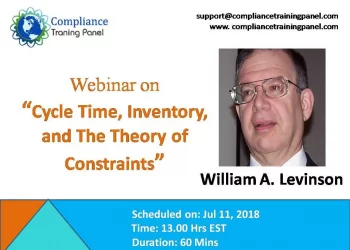Inventory is one of the
Toyota Production System's Seven Wastes, and it is directly proportional to
cycle time; the amount of time necessary for a customer order to go through a
manufacturing (or service) process. The Theory of Constraints explains why most
cycle time is waste in most processes. First, no process can operate more
rapidly than its constraint or capacity-constraining resource (CCR). Second,
favorable variation in processing times does not offset unfavorable variation
because time lost at the constraint is lost forever. (This also explains
traffic jams that appear out of nowhere during rush hour.) This webinar will
explain the Theory of Constraints and also provide attendees with production
control methods to reduce inventory and cycle time enormously.Objective : Attendees will learn Dr. Eliyahu Goldratt's Theory
of Constraints, understand how variation in processing and material transfer
times make it impossible to operate a balanced factory at full capacity.
Attendees will also learn about the drum-buffer-rope (DBR) production control
system that confines inventory to a buffer at or leading to the
capacity-constraining resource to ensure that it never runs out of work, while
eliminating inventory from the rest of the process.Areas Covered in the Session : 1: The Theory of Constraints, and its
relationship to project management 2:Variation in processing and material
transfer times make it impossible to operate a balanced factory (one in which
the workload is the same at each operation) at full capacity.
- Henry
Ford, however, claimed to have done exactly that—and his factories carried
only minimal work in process on conveyors and work slides between
operations. He succeeded by eliminating the variation in question.
- Variation
can be suppressed through standard work and the job breakdown
sheet—concepts that are actually more than 200 years old.
- Recognize,
therefore, that pull production control is containment for problems caused
by variation, rather than an actual corrective action for it.
3:Theory of Constraints economics
- Inventory
is an asset only in cost accounting.
- Overhead
is a sunk cost
- Overproduction
to absorb overhead and other costs wastes money and increases cycle time
- Quantity
bargain purchases are often not bargains, and Benjamin Franklin (an
influence on Henry Ford) told us this more than 200 years ago.
- Labor
is a variable cost only when overtime is being paid; it is otherwise a
fixed cost for all practical decision-making purposes.
- Lost
time at the constraint can be as expensive as rework or even scrap (due to
loss of the opportunity to make saleable items).
- Engineering
or managerial economic principles; marginal costs, revenues, and profits
for decision-making purposes
4:Theory of Constraints performance
measurements
- Throughput
(more is better)
- Inventory
(less is better)
- Operating
expense (less is better)
5:The drum buffer rope (DBR) production
control system
6:Techniques for variation reduction
Who Will Benefit:
Manufacturing and quality engineers and technicians.
About Speaker:
William A. Levinson, P.E., FASQ, CFPIM, is the
owner of Levinson Productivity Systems PC. He holds professional certifications
from the American Society for Quality, APICS, and Society of Manufacturing
Engineers.
Event URL: https://www.compliancetrainingpanel.com/Webinar/Topic?WB=MP00104
Organizer: Compliance Training Panel
Website: www.compliancetrainingpanel.com/Webinar/Live
Phone: 844-216-5230
Contact: support@compliancetrainingpanel.com


